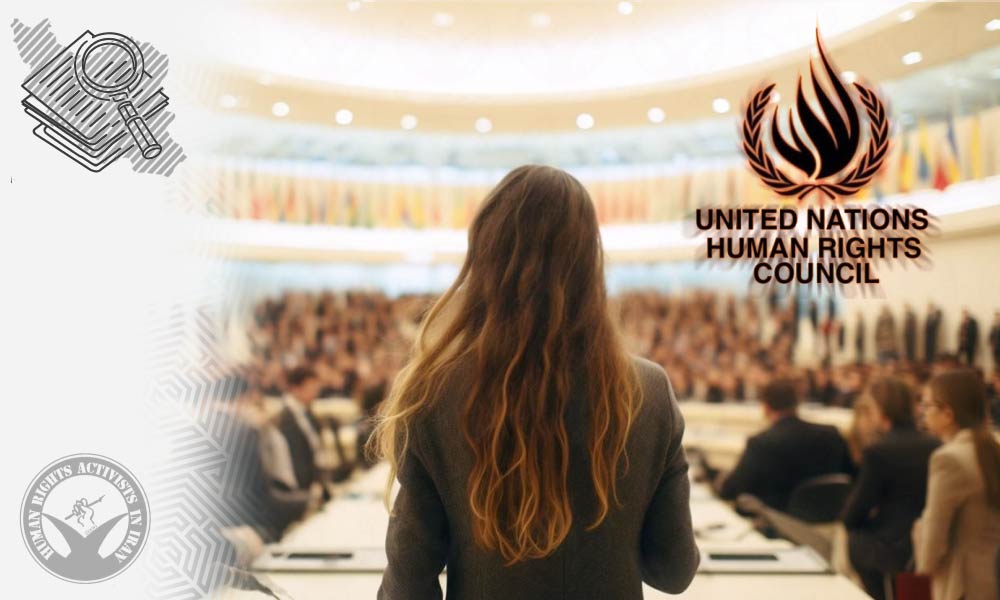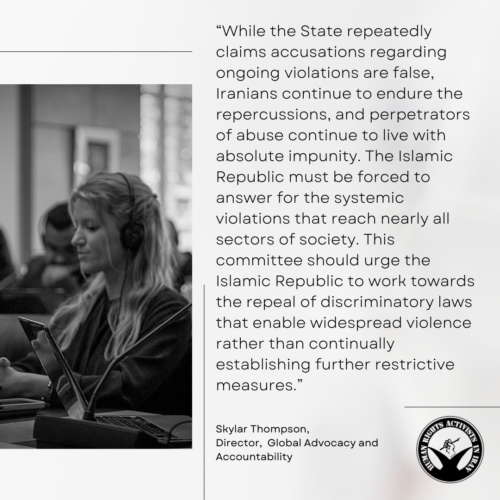HRANA News Agency – While March 8, International Women’s Day, is a time to honor women’s struggles for equality worldwide, in Iran, it serves as a stark reminder of systematic oppression and ongoing violations of women’s rights. Instead of progress, Iranian women continue to face state-imposed restrictions, harsh punishments, and widespread repression, enforced by officials who use their power to limit freedoms, enforce discriminatory laws, and suppress dissent.
This report sheds light on 18 individuals who, over the past year, have played a key role in the oppression of women in Iran. From judges issuing death sentences and long-term imprisonments to officials implementing repressive policies like the “Noor Plan”, these individuals have been instrumental in violating women’s rights and enforcing systemic gender discrimination.
Women’s Rights Under Attack in Iran
While women in many parts of the world have made strides toward gender equality, in Iran, their fundamental rights continue to be systematically violated. The state’s grip on women’s personal and public lives extends across various domains, including:
- Legal and social restrictions on marriage, child custody, employment, and personal freedoms
- The violent suppression of protests and civil activism
- Compulsory hijab laws, enforced through harsh crackdowns
- Targeted arrests and severe sentencing of women advocating for change
One of the most blatant aspects of this repression is the direct role of judges, legislators, and government officials in depriving women of their rights, freedoms, and human dignity. These individuals not only enforce restrictive laws but also suppress protesters, issue heavy sentences, and use violence to crush any efforts toward change.
The 18 Officials Behind the Repression of Women
This report, compiled using data from Spreading Justice (SJ), a database of human rights violators, identifies 18 individuals who have played a direct role in enforcing discriminatory policies and punishing women who resist oppression. These include:
- Judges who have sentenced female protesters to death and lengthy prison terms
- Officials involved in oppressive programs like the “Noor Plan,” aimed at enforcing compulsory hijab and restricting women’s freedoms
- Security forces and judicial authorities responsible for violent crackdowns, intimidation, and human rights abuses
This list is not just a collection of names—it serves as evidence of the systematic persecution of women in Iran. Whether through prison sentences, executions, or street-level repression, these officials have weaponized the law to silence women and enforce state control through fear, intimidation, and punishment.
A Call for Global Action
HRANA urges the international community, human rights organizations, and governments committed to human rights principles to treat this report as documented proof of widespread violations of women’s rights in Iran. Targeted sanctions against these individuals, diplomatic pressure, and legal action in international courts are crucial steps in holding them accountable for their role in state-sponsored oppression.
As Iranian women continue to resist and defend their rights, global silence would amount to complicity in their oppression. The international community must stand in solidarity and take concrete action against human rights violators to confront this systematic repression of women.
Publishing this report is a step toward raising awareness and mobilizing global attention to the widespread human rights abuses Iranian women endure—a call to action that cannot be ignored.
 | 1. Abolghasem Salavati Example of actions taken: Issuance of a death sentence for Varishe Moradi on the charge of “moharebeh” (waging war against God) by Branch 15 of the Tehran Revolutionary Court, presided over by Judge Abolghasem Salavati. |
 | 2. Iman Afshari Example of actions taken: Issuance of a death sentence for Pakhshan Azizi on the charge of “moharebeh” by Branch 26 of the Tehran Revolutionary Court, presided over by Judge Iman Afshari. |
 | 3. Ali Razini Example of actions taken: Approval of Pakhshan Azizi’s death sentence by Branch 39 of the Supreme Court. Razini, who presided over this branch, was shot and killed at his workplace on January 18. |
 | 4. Ghasem Mazinani Example of actions taken: Rejection of Pakhshan Azizi’s request for a retrial by Branch 9 of the Supreme Court, presided over by Ghasem Mazinani. |
 | 5. Ahmad Darvish Goftar Example of actions taken: Issuance of a death sentence for Sharifeh Mohammadi on the charge of “moharebeh” by Branch 1 of the Rasht Revolutionary Court, presided over by him. |
 | 6. Darvish Goftar (son of Ahmad Darvish Goftar) Example of actions taken: After the Supreme Court overturned the death sentence of Sharifeh Mohammadi, Darvish Goftar, as the head of Branch 2 of the Rasht Revolutionary Court, reissued the death sentence. |
 | 7. Seyed Mousa Asaf al-Hosseini Example of actions taken: Issuance of a one-year prison sentence, two years of exile to Rasht, a two-year travel ban, and a two-year ban on using social media for Hamideh Zarei, one of the detainees of the 2022 nationwide protests, by Branch 1 of the Karaj Revolutionary Court, presided over by Seyed Mousa Asaf al-Hosseini. |
 | 8. Amirhossein Bankpour Fard Example of actions taken: One of the architects and supporters of the “Family Protection Bill through the Promotion of Chastity and Hijab” during his tenure in the Cultural Commission of the Islamic Consultative Assembly (Parliament). |
 | 9. Hossein Mirzaei Example of actions taken: One of the drafters, supporters, and voters of laws violating human rights, including the “Family Protection Bill through the Promotion of Chastity and Hijab.” He also supported the “Family Protection and Population Growth Law.” |
 | 10. Zohreh Elahian Example of actions taken: Participated in drafting, supporting, and voting for human rights-violating laws, including the “Family Protection and Population Growth Law.” As a member of the 11th Parliament, she supported the police operation known as “Project Noor” (a campaign initiated by the Islamic Republic’s Law Enforcement Command on April 13, 2024, to enforce mandatory hijab laws) and urged other responsible institutions to fulfill their legal duties in imposing mandatory hijab. |
 | 11. Hajar Chenarani Example of actions taken: As one of the members and the first secretary of the Judicial and Legal Commission of the Parliament, she played a role in drafting and supporting the “Family Protection Bill through the Promotion of Chastity and Hijab.” |
 | 12. Hassan Mofakhemi Shahrestani Example of actions taken: As the law enforcement commander of Mazandaran province, he was responsible for violations of women’s rights during his tenure. In one instance, in early June 2024, law enforcement officers in Noor County, Mazandaran province, fired at a vehicle that was on the impound list due to hijab violations. According to reports, contrary to the police’s claim of shooting at the vehicle’s tires, officers fired at least once “at the driver’s door,” hitting a young woman named Arezou Badri. |
 | 13. Heydar Susani Example of actions taken: As the law enforcement commander of Bushehr province, he was responsible for the arrest of women over their attire and for sending warning messages about non-compliance with mandatory hijab in vehicles in the province. |
 | 14. Mahmoud Hafezi Example of actions taken: As a mid-ranking commander in the Islamic Republic’s Law Enforcement Force, he played a role in violating women’s rights in Rasht. In one instance, a video was published showing a violent altercation between morality police officers and a young woman, highlighting the police’s enforcement of hijab laws in the city. |
 | 15. Mohammad Movahedi Azad Example of actions taken: As the Attorney General, he was one of the key figures in supporting and enforcing “Project Noor” and mandatory hijab policies nationwide. In addition to repeated endorsements of “Project Noor,” the Attorney General’s Office announced that a draft directive had been prepared for the Islamic Republic’s Law Enforcement Command to implement this plan. |
 | 16. Ahmadreza Radan Example of actions taken: As the Chief Commander of the Islamic Republic’s Law Enforcement Force, he was directly responsible for enforcing mandatory hijab policies, including “Project Noor,” across Iran. |
 | 17. Gholamhossein Mohseni Eje’i Example of actions taken: As the head of the Judiciary, he was directly responsible for imposing restrictions, crackdowns, and enforcement measures related to mandatory hijab, the drafting of the “Hijab and Chastity Bill,” and the implementation of “Project Noor.” |
 | 18. Ghasem Rezaei Example of actions taken: As the Deputy Commander-in-Chief of the Law Enforcement Force, he was responsible for implementing mandatory hijab policies. In one instance, two teenage girls on Vatanpour Shomali Street in Tehran were severely beaten by officers enforcing “Project Noor” due to their lack of hijab. In a published video, officers were seen violently dragging one of the girls to the ground and forcing her into a white police van. The Morality Police later claimed that one of the female officers had broken her finger in the altercation and threatened the girls against filing a complaint. |
The individuals named in this report represent only a small fraction of the vast network of officials responsible for the repression, discrimination, and systematic violations of women’s rights in Iran. Through their decisions, policies, and actions, these figures have trampled on fundamental freedoms, reinforcing a system that seeks to control, silence, and punish women for demanding their basic rights.
Yet, despite this relentless oppression, Iranian women continue to resist. Their unwavering fight for justice, freedom, and equality is a testament to their courage and determination in the face of state-imposed restrictions and brutality.
Documenting these violations is not just about bearing witness—it is a crucial step toward accountability. Raising international awareness and applying legal, diplomatic, and economic pressure—including targeted sanctions against those responsible—can play a key role in challenging the Iranian government’s systematic oppression of women.
In addition to this report, HRANA has published a list of female political and ideological prisoners in Iran, detailing the names and cases of women imprisoned for their beliefs and civil activism. Readers are encouraged to refer to that report for a broader understanding of the deep-rooted gender-based persecution Iranian women endure.
The fight for women’s rights in Iran is far from over—but neither is the resolve of those who continue to stand against injustice. Global solidarity and concrete action are imperative to ensure that these violations do not go unanswered.







